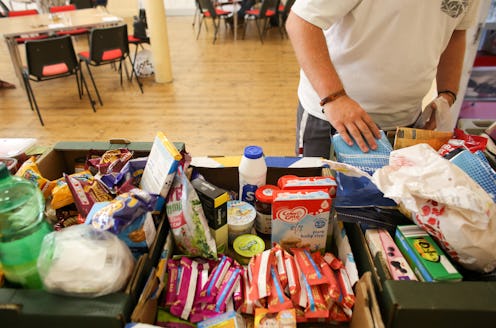News
5 Ways To Address Food Insecurity As Trump Threatens SNAP Benefits For 755,000 People

The Trump administration recently announced a new proposed rule for the Supplemental Nutrition Assistance Program (SNAP), which will require some recipients to work in order to receive aid. According to NPR, the rule could leave up to 755,000 people without access to the food stamps they need. Following the administration's proposal, there are a number of ways to get relief if you're experiencing food insecurity right now.
Though the public comment period on the proposed rule ended Tuesday, you can still read through the more than 46,000 comments that were made, many of which make it clear how essential this program is to them. One commenter wrote, "SNAP provides seniors on very limited income the ability to have adequate food and medication. Without SNAP seniors would need to choose between food or their much needed medications."
Another wrote:
As a result of a medical condition, between 2010-2012 I was unable to work. That was the first since I came to this country, that I was unable to support myself and my family, which, at that time included a new born baby. The SNAP program provided a most needed support and was there until I was able to stand on my feet again and continue my professional work. Please consider the thousands of family that like me few years ago, relay in this program to feed themselves and their love one.
If you're concerned about these changes, you can learn more about the SNAP program in general, as well as the new proposed rule. And in response to the proposed protocol, here are some things you can do if you're experiencing food insecurity and looking for relief.
Visit Your Local Food Bank
One of the immediate things you can do is contact or visit your local food bank. Feeding America is an organization that has food banks distributed across the country; you can just plug your zip code into their website to find the one closest to you.
Feeding America also has a page that can help you find food through other programs and forms of assistance, if none of their 200 food banks are near enough to you.
Visit Your Local Church Or Community Center
Churches, community centers, and other local departments are another resource you can use, not just to inquire about their food stores but to use them to amplify your cause. Often, churches and community centers will have systems in place that work to feed and clothe those who are struggling, so it's possible these places will be able to assist you, if not to send you in the right direction.
The cities of Albuquerque, New Mexico, and Bloomington, Minnesota, for instance, both have community centers and initiatives that offer food relief programs. Similarly, the Los Angeles Department of Recreation and Parks has a program that offers free lunch to kids and teenagers in the summer at 100 parks across the city.
Contact Your Legislators
Contacting your legislators, both locally and in D.C., has two essential purposes. First, it might help you to locate more resources than you would on your own, since your local and federal legislators' offices likely have information to help you combat food insecurity in their state. Second, it will serve the doubly important task of letting them know how their own constituent is hurting, which might help them to make informed decisions on your behalf in the future.
This government-run search engine will help you find all of your representatives, from the local to the federal level.
Contact These Food Relief Organizations
There are a number of food relief organizations that work solely to make sure you have resources in this very situation. Here are a few:
- Feeding America (mentioned above)
- Food Bank for New York City
- Freedom From Hunger (California-based)
- Meals on Wheels
- Share Our Strength
- The Salvation Army
- The Red Cross
- Juibilee USA
Talk To Local Restaurants About Food Overflow
If you're comfortable with it, you can speak with local restaurants to ask what they do with their overflow. Oftentimes, restaurants have a system set up where they donate certain types of leftover food to nearby shelters, food banks, and organizations. Finding out where they donate the food could help you to be able to contact that resource directly. This list by Delish offers up 10 chain restaurants who donate their food on a wide scale, as well as the organizations or nonprofits that receive this food.
The most important thing to remember, if you are experiencing food insecurity, is that this is an incredibly common problem in the United States. According to Feeding America, an estimated one in eight Americans were food insecure in 2017. You are not alone, and if you reach out to some of these organizations, there's a good chance you will be able to receive the care, respect, and help that you deserve.